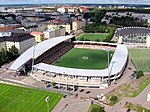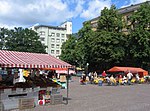Paavo Nurmi statue

The Paavo nurmi statue (also known as the Paavo Nurmi runner statue) is a whole-body sculpture of runner Paavo Nurmi, the most successful Olympic athlete in Finland, made by sculptor Wäinö Aaltonen. The bronze sculpture was made in 1925 and there have been four additional casts of it. The statue has become a symbol for Finnish sport and the independent Finnish nation as well as an envoy of the image of Finland.The order represented the start of the career as a trusted national artist for Aaltonen. He had earlier made a significant local impact in the Turku area. The sculpture order was given to Aaltonen as an "improvement prize" as he was considered the most talented among young sculptors. The sculpture was also the first sculpture representing an athlete to be ordered by the state of Finland.
Excerpt from the Wikipedia article Paavo Nurmi statue (License: CC BY-SA 3.0, Authors, Images).Paavo Nurmi statue
Mäntymäentie, Helsinki Töölö (Southern major district)
Geographical coordinates (GPS) Address Nearby Places Show on map
Geographical coordinates (GPS)
| Latitude | Longitude |
|---|---|
| N 60.184444444444 ° | E 24.9275 ° |
Address
Mäntymäentie
Mäntymäentie
00260 Helsinki, Töölö (Southern major district)
Finland
Open on Google Maps










